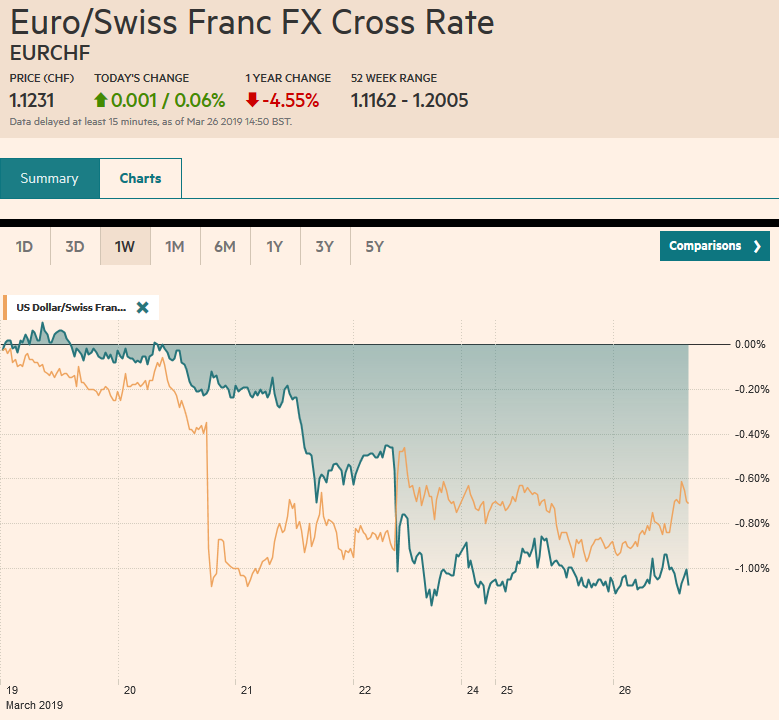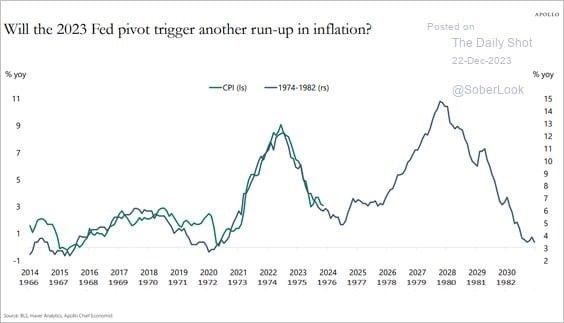Swiss FrancThe Euro has risen by 0.06% at 1.1231 |
EUR/CHF and USD/CHF, March 26(see more posts on EUR/CHF, USD/CHF, ) Source: markets.ft.com - Click to enlarge |
FX RatesOverview: The sell-off in equities seemed to peak yesterday, and US indices were narrowly mixed. Traders found comfort in that performance, even though the S&P 500 finished a little below 2800, and took the markets in the Asia-Pacific region higher, except in China, where the Shanghai Composite fell 1.5%. Chinese shares saw the most foreign sales over the link with Hong Kong since the second connect was opened a couple of years ago. The Nikkei led the Asian markets higher with a 2.1% gain that nearly closed the gap created with yesterday’s sharply lower opening. European bourses are struggling to follow suit and have a four-day drop in tow. After a dramatic bond market rally over the past few days, some profit-taking appears to be kicking in, and yields in Europe and the US and edging higher, after the US 10-year yield briefly traded below 2.40%, the same level the Fed pays on reserves. The foreign exchange market is particularly quiet. The dollar is slightly firmer against most of the major currencies. The Australian dollar is the notable exception, it is up about 0.2%. Higher yields and higher equities appear to be weighing on yen. With the greenback near JPY110.15, the yen is off about 0.15%, making it the weakest through the European morning. |
FX Performance, March 26 |
Asia Pacific
With China’s President Xi in Europe, ahead of the summit later this week, it is not surprising that new deals are being signed with its hosts. Yesterday, China announced it was buying $35 bln of planes from Airbus, which includes 290 A320s, which compete with Boeing’s troubled 737 Max that has been grounded. China’s humungous market gives it leverage and some of the technology transfers are not the product of espionage or stealing but given to secure lucrative contracts. Other contracts were signed, but the Airbus deal captured the people’s attention.
Separately, reports suggest that China’s imports of US soy jumped nearly seven-fold in February over January to almost 908k tons. While this is a step in the right direction, recall that in February 2018, China bought 3.3 mln tons of soy from the US. Another big jump in US soy exports to China seems to have taken place this month. Some estimates suggest as much as 6.5 mln tons of soy may have been shipped. China has replaced part of the US shipments with Brazil’s soy (+14% year-over-year in February) and Argentina (which sold little to China in 2018).
New Zealand unexpectedly reported a trade surplus in February. Although seasonal patterns tend to be favorable, the NZ$12 mln surplus compares with forecasts for an NZ$200 mln deficit after a revised nearly NZ$950 mln shortfall at the end of 2018. Exports firmed, while imports slipped, but the important takeaway is that on a rolling 12-month basis, New Zealand’s trade deficit reached NZ$6.62 bln. By this measure, the trade deficit has more than doubled since the end of 2017. Meanwhile, the benchmark 10-year yield is at new record lows near 1.85%
Samsung warned that sagging memory chip and display prices means it will miss its earnings estimates when it reports on April 5. However, it appears the worst may be behind it, and DRAM pricing for March will be reported later this week. Samsung finished little changed, and the Kospi eked out a small gain.
The dollar has been confined to a narrow range against the yen as it continues to straddle the JPY110.00 level. Firmer yields and equities would take a prop away from the yen. Today there are options for $1.72 bln struck at JPY110.10-JPY110.15. Look for a wider band to prevail-JPY109.70 and JPY110.50-in the coming days. The Australian dollar recovered from near $0.7065 yesterday to nearly $0.7130 today. The intraday technicals are consistent with a push to marginal new highs, but we suspect it is a better sell in front the of $0.7170 area it approached in response to the dovish Fed statement last week. At $0.7125, the Aussie is in the middle of two expiring options at $0.7100 (~A$500 mln) and $0.7150 (~A$720 mln)
Europe
Brexit developments dominate market talk today. Prime Minister May lost a vote yesterday 329-302 that sees the House of Commons take near-term control of the debate. May admitted she does not have the support to bring the Withdrawal Bill for a third vote. Tomorrow, Parliament will debate and vote (non-binding) on alternatives. These may include a customs union, a second referendum, and leaving without an agreement.
Although May’s leadership and approach are unlikely to be viewed favorably by history, the immediate risk is that Parliament is also weak and divided. Many talk about what was first offered as a non-binding referendum that both the Conservatives and Labour agreed to accept as binding as if it were clear and obvious what the 52% meant when they voted to leave the EU. This is not the case. Returning the issue to the people for clearer instructions may not undermine representative government. The most likely scenario at this juncture is for a long-extension, and this will be underscored if Parliament cannot find a majority for any alternative. However, there may be one more card to play. It appears that if May would offer to resign, she could still forge a compromise.
The Turkish lira returned to the pre-weekend high early today before retreating again. The dollar was sold to TRY5.4750 compare to nearly TRY5.46 before the big sell-off at the end of last week. The overnight swap rate jumped over 96% yesterday as foreign holders of lira tried selling it but did not find buyers. The dollar has returned to TRY5.55 by late morning activity in Europe.
The euro has been confined to a fifth of a cent range above $1.13. It is inside yesterday’s range, which was inside last Friday’s range. Yesterday’s upside surprise on the German IFO survey has given rise to speculation that a recovery in Q2 is increasingly likely. Resistance is seen in the $1.1340-$1.1360 area. Sterling has slipped marginally through yesterday’s lows (~$1.3160) late in the European morning. The $1.3125-$1.3150 houses retracement objectives and past congestion and likely offers sufficient support today.
America
There is much consternation over the inversion of the US yield curve. The conditions that lead to an inversion of the curve typically are the same that lead to an economic downturn. However, there are long and variable lag times, and many(~2/3) economists had already forecast a recession over the next one-two years. Context is important too. In the past, when the curve has gone inverted, the short-end is more than twice current levels. There are around $10 trillion in negative yielding bonds in Europe and Asia, and the latest leg down in yields seemed to be sparked by the dismal EMU flash PMI before the weekend. Still, many argued that it was QE that acted to depress yields. Clearly, something else besides Fed and ECB purchases is driving yields lower.
Some fears that unwinding the balance sheet was going to tighten conditions by driving up rates. The US 10-year yield peaked at the start of Q4 just as the Fed’s unwind reached terminal velocity of $50 bln a month. As the unwind continued, the yield fell more than 80 bp through yesterday. While the balance sheet operations will be completed by the end of Q3, the debate over some of the other issues surrounding the balance sheet are coming to the fore. Yesterday, at least three officials opined about the duration of the balance sheet. The average maturity of the Fed’s portfolio is near eight years, while the average maturity of the outstanding Treasuries is near 5.8 years. Rosengren and Harker saw advantages in holding a shorter duration portfolio, though Evans seems to emphasize the risks. Daly joins Harker and Evans in public speeches today.
The highlights for today’s economic calendar include US February housing starts. Some payback is likely for the 18.6% surge in January. Economists look for a small decline (~1.5%). January house prices will also be reported. Mexican retail sales fell 3.2% in December and are expect to have bounced back in January. A 2% gain is expected.
The US dollar peaked yesterday near CAD1.3445. Higher oil prices and firmer equities may give the Canadian dollar a better bid, but the two-year rate differentials are bouncing back in the US favor. Look for support near CAD1.3250. The Mexican peso is trading quietly near yesterday’s best levels. The US dollar is hovering just above MXN19.00. The Dollar Index looks trapped between the five-day average (~96.40) and the 20-day average (~96.65).
Graphs and additional information on Swiss Franc by the snbchf team.
Full story here Are you the author? Previous post See more for Next postTags: #GBP,#USD,$AUD,$CAD. $EUR,$EUR,$JPY,EUR/CHF,newsletter,NZD,SPX,USD/CHF






























